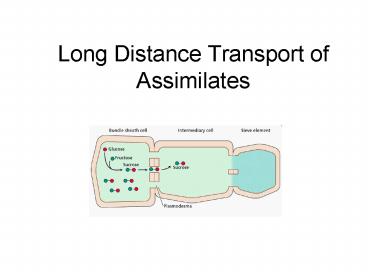Long Distance Transport of Assimilates - PowerPoint PPT Presentation
1 / 20
Title:
Long Distance Transport of Assimilates
Description:
Long Distance Transport of Assimilates Transport of Assimilates Overview Phloem allows mass flow of carbohydrates from source to sink (translocation) Phloem loading ... – PowerPoint PPT presentation
Number of Views:353
Avg rating:3.0/5.0
Title: Long Distance Transport of Assimilates
1
Long Distance Transport of Assimilates
2
Transport of Assimilates
3
Overview
- Phloem allows mass flow of carbohydrates from
source to sink (translocation) - Phloem loading photosynthates from mesophyll to
sieve tubes - Two pathways
- Symplasmic
- Apoplasmic
- Correspond to ecological distribution
4
The phloem-loading pathway
- Production compartment
- Mesophyll cells
- Bundle sheath cells
- Collection compartment Phloem
- Companion cells
- Sieve elements
- Export compartment Phloem
- Sieve tubes
- Sieve elements
5
The phloem-loading pathway
6
Major transport compounds
- Why not glucose?
- Sucrose
- Linking sucrose with 1,2,or 3 galactose
- ? Oligosaccharides
- Raffinose
- Stachyose
- Verbascose
7
Chemical structure of major sugars
8
Minor vein anatomy
- Large differences in plasmodesmatal connectivity
between mesophyll and phloem, range from - Entirely symplasmic (Type 1)
- 60 plasmodesmata mm-2
- Evergreen trees
- Entirely apoplasmic (Type 2)
- 0.03 plasmodesmata mm-2
- Annual herbs
- Decrease in plasmodesmatal connectivity between
minor vein phloem and mesophyll during evolution
from evergreen trees to annual herbs
9
Two phloem-loading pathways
10
Taxonomic distribution of minor vein types
(Gamalei 1989)
11
Evolution of minor vein anatomy
12
Transport against a concentration gradient
- Symplastmic pathway
- Sucrose metabolized to make galactose in
intermediary cells - Sucrose linked to make oligosaccharides in an
ATP-requiring process - Too large to diffuse back to mesophyll
- polymerization trap mechanism
- Apoplasmic pathway
- Companion cells between mesophyll and sieve
elements take up sucrose - Sucrose-proton-co-transport carrier in plasma
membrane (requires ATP) - transfer cells
13
Lythrum salicaria (Purple loosestrife)
Senecio vulgaris (Common groundsel)
Transfer cells (T) Sieve tube (S) Xylem
(X) Mesophyll cells (MC)
Intermediary cells (I) Sieve tube (S) Xylem (X)
14
Variation in Transport Capacity
- Species with symplastic phloem-loading pathway
have lower capacity to export - Accumulate more non-structural carbohydrates
- Why?
- Limited by oligosaccharide production
- Raffinose solubility at low temperatures
15
Raffinose SolubilityAs temp ? other sugar
solutes utilized
16
Phloem Loading and Ecological Distribution
- Apoplasmic pathway dominates in temperate and
arid zones - Symplasmic pathway typical in tropics
- Raffinose common in tropical trees vines
- Ancient familes show symplasmic configuration
progressive evolution toward apoplasmic phloem
loading pathway
17
Phloem Loading and Ecological Distribution
18
Phloem Loading and Ecological Distribution
- Environmental Factors
- Extreme temperatures
- lt10C plasmodesmata may not function well
- lt10C oligosaccharide production ?
- Viscosity of oligosaccharides ? with decreasing
temp - Water stress
- Consistent types found in hot deserts
- Bundle sheath cells of C4 plants
19
Transport in climbing plants
Trees
Lianas
Lianas
Trees
20
Phloem Loading and Plant Distribution Summary
- Symplasmic pathway with its trapping mechanism
sufficient in tropics - As plants evolved into cooler habitats,
symplasmic pathway became limiting - Apoplasmic pathway important trait for species to
occupy cool habitats - Inhibition of photosynthesis at cool temperatures
may be a secondary effect of feedback inhibition - Does the proton-pump of transfer cells require
more ATP than the polymerization in intermediary
cells? - How does this affect the costs and benefits of
each pathway?































